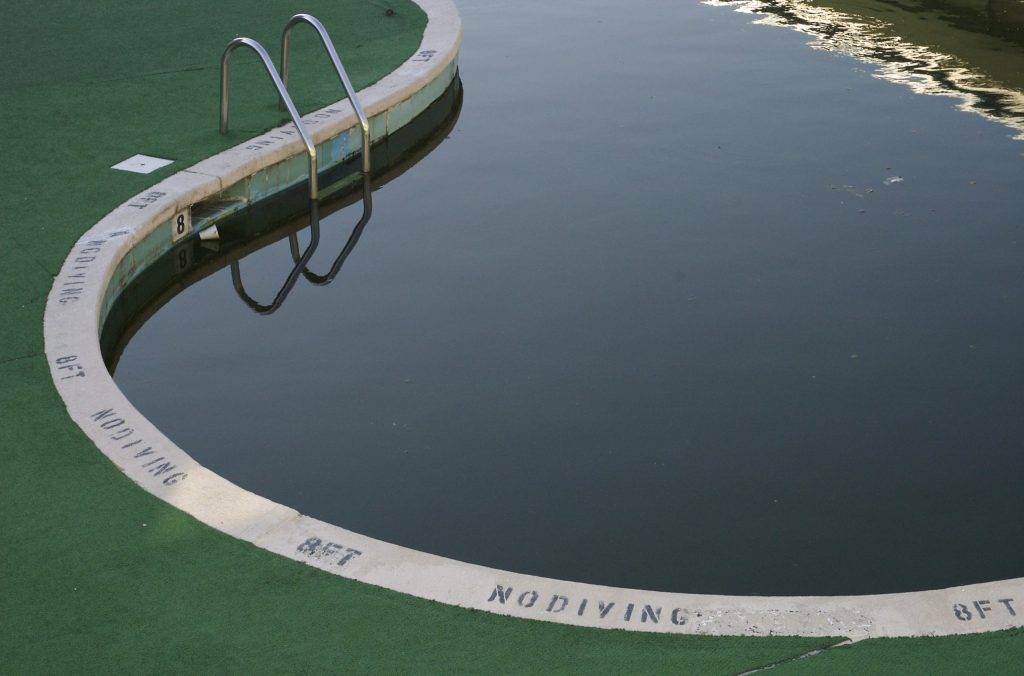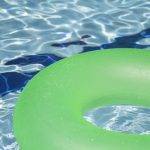You’ve been planning all month long to host your daughters birthday party, and it’s all centered around that pool in the back yard. The weather is perfect and the grill is ready to go, but on the day you wake up to a mess of a pool. You now have a decision to make, take a risk and let the kids dive into the cloudy pool water or tell them no. Before making any decisions let’s take a minute and look if you really can swim in a green pool.
Can you swim in a green pool?
Before diving into any details I’d first like to ask the question why? Why would anybody wish to swim in a pool that’s got algae taking over?
There are some safety concerns about a quick swim in a green pool, and the largest is drowning. There’s always a risk that somebody could find themselves underwater not able to help themselves. The green water will make it where those standing beside the pool can’t see them. Because of this it’s best to avoid swimming whenever you cannot clearly the bottom of the deep end.

Now I know some are thinking that your kids are screaming to swim and this will never happen. You maybe thinking you’ve got a party planned and you don’t want to disappoint your guests. But it does happen, and I suspect you don’t want to be left with a death like happened here.
Maybe I’m just facing cloudy pool water!
I’m sure there’s some of you who are thinking your pool isn’t green, it’s just rather cloudy water. It’s a shade of blue, surely it’s clean and healthy water, right?? Well, maybe.
Speaking cautiously, all water has a risk of causing illness. Cloudy water is almost always because of algae forming, and algae forming is almost always a result of a lack of sanitizer. This is why pool owners use an appropriate EPA sanitizer like chlorine in their water. And not just a one-time dose, but something that remains in the water working to kills germs and algae until the next dose of sanitizer.
Because your pool has a low sanitizer level you not only aren’t killing algae fast enough, but you also may not be killing various viruses or person to person diseases. So if your pool is cloudy, but the bottom is visible, AND you have already raised the sanitizer level for at least 12 hours with proper circulation, so you are actively addressing the low sanitizer situation, then the pool is likely to be generally safe to swim from a germ perspective, although algae is still living and present.
Algae itself is not particularly unhealthy from a swimming perspective. However, if you have a cloudy pool and have not yet begun actively addressing the low sanitizer level for at least 12 hours, then the discussion below of possible communicable diseases is VERY pertinent and should lead you to NOT allow swimming at that point. You just don’t know what could have brewed up during the low/no sanitizer period.
But what germs could be in the water that is a risk to me, you ask??
Well, that kid from down the street who had “stomach flu” diarrhea a couple of days ago? He can still spread germs in the water for up to 2 weeks after. And if you take in a bit of that water through your mouth or nose, or perhaps breath in the aerosolized spray while playing, you too could come down with a nasty GI bug. The CDC recommends avoiding swimming for 2 weeks past any diarrhea type illness. Even though the symptoms are gone, you can continue to shed germs for a while after.
The more common “bugs” causing risk include Shigella, Giardia, Norovirus and E.coli. and Cryptosporidium. A less common “bug” can even be Hand, Foot and Mouth Disease.
Unless swimmers shower before entering the pool, you can take 3 swimmers and between them you’ll have a Tic-Tac candy mint amount of fecal material between them entering the pool water. Direct person to person contact can also spread germs, viruses and fungal infections.
External ear infections (Otitis Externa) can also be caused by bacteria in pool water if it remains in the ears. It can be a quite painful cellulitis. Drying your ears well after swimming can help you avoid this. Tilt your head to each side and pull your earlobe in various directions can help drain your ears. A warm (not hot) blow dryer can also help. There are Swimmers Ears drops available OTC which usually contain acidified alcohol. These help to both dry the ear and make it Inhospitable to any lingering germs. A homemade version of Swimmers Ear is a 50:50 mixture of rubbing alcohol and white vinegar in a dropper bottle.
Another problem some pools and hot tubs can have is when they cause eye irritation or lung irritation. Breathing in the mist of contaminated water carrying Legionella bacteria can cause
Legionnaires’ disease.
Ever go to a pool and notice that strong “bleachy” smell?? Sure, you say you smell “chlorine” but a healthy pool doesn’t have a chlorine smell. What you’re really smelling is that whatever chlorine was in the pool is overwhelmed by sweat, urine, and germs in the water and you’re smelling the Combined Chloramines. Gross, huh? The cure for this is actually *more* chlorine to overcome the cooties in the water. Proper water maintenance requires regular water testing and a planned effective method of chlorination of recreation water to avoid disease transmission.
Are there any other cooties I should be concerned with around the pool?
There are a few other items you should be concerned about around the pool, but with some simple steps you can greatly reduce the risk of coming down with any other “cooties.”
How about that nasty rash you got after soaking in the hot tub with cloudy water on your last cruise? Small blisters and rash, predominantly in those tender areas where your bathing suit covers by holding the contaminated water directly against your hair follicles where it enters the follicle and causes infection. Yuck! Best chance to avoid it is to get out of that bathing suit soon after soaking and shower off well.
If you have a rash, a cut or wound its best to stay out of the pool. While you consider it safe if you cover the area with a bandage, you risk it developing an infection.
Sharing beach towels poolside increases the risk of sharing MRSA or lice. Lice aren’t killed in a chlorine pool and usually hang on to hair anyway, but avoid using communal brushes and combs after a swim since then you could pick it up.
In conclusion
A pool owner should NEVER consider a quick swim in a green pool as the risks of drowning are just too great. Additionally cloudy pool water can be just as dangerous due to various viruses or person to person diseases being transmitted due to a lack of sanitizer. If you’re thinking of a quick dive or giving into your daughter and letting her host that birthday party in the pool, DON’T! Instead head to the dollar store and buy some water balloons and some squirt guns. Let them enjoy the day playing in the yard while you read up on how to SLAM the pool.





